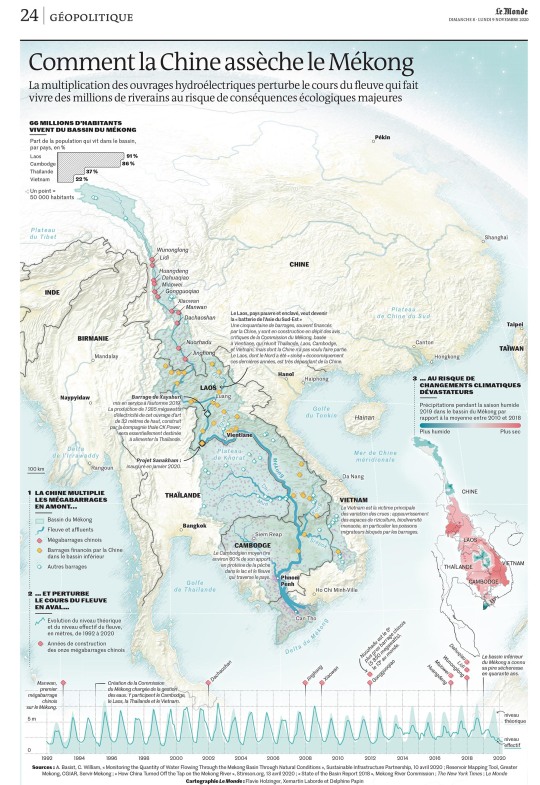#XemartinLaborde
Explore tagged Tumblr posts
Photo

📌[ÉCHO] De mon atlas paru aux éditions Autrement (avec des cartes signées @XemartinLaborde), il est question dans @Le Figaro Magazine de ce week-end. En panne d'idée cadeau 👇
https://cutt.ly/9UaziqU
#atlas#découvertes#géographie#histoire#exploration#carte#éditions autrement#xemartin laborde#récit#stéphane dugast
1 note
·
View note
Photo

How China is drying up the Mekong.
by @XemartinLaborde
The proliferation of hydroelectric works disrupts the course of the Mekong river, which supports millions of residents at the risk of major ecological consequences. 66 million inhabitants live in the Mekong basin.
Le Monde, 8-9 November 2020
Flavie Holzinger, Xemartin Laborde and Delphine Papin
89 notes
·
View notes
Photo

Africa facing the challenge of preservation.
by @XemartinLaborde
To save the fauna and the environment, the states of the continent, resort to armed organizations such as African Parks in the Central African Republic.
Today, more than 7,000 protected areas are recognized in Africa. The average management cost of a protected area is estimated at between 7 and 8 dollars per hectare per year. For an area of 5,000 square km, the state should have an annual budget of 4 million dollars.
Sources: Protected Planet; IUCN, Red List of Threatened Species; Acled; Traffic, 2017; Control Risks; African Parks; B. Chardonnet, Reconfiguring protected areas in Africa, IUCN, 2019
Le Monde infographic: Francesca Fattori, Xemartin Laborde and Audrey Lagadec
Le Monde, 10-11 May 2020
82 notes
·
View notes
Photo

Russian military operations abroad in the past decades.
by @XemartinLaborde
In twenty years, Vladimir Putin has committed his soldiers to several theaters of operations, placing military force at the center of his policy
Chechnya, 1999-2009: In September, the Prime Minister, Vladimir Putin, launches a “counter-terrorism operation” in Chechnya, whose separatists are accused of having committed attacks in Russia. Grozny, already devastated by the war from 1994 to 1996, was pounded by the air force. Control of the region is locked by the installation in power of Akhmad Kadyrov. Russia's new strongman won the 2000 presidential election in the first round.
Georgia, 2008: After clashes between South Ossetian separatists and the Georgian army, the latter started a military intervention. The conflict spreads to Abkhazia. Russia is deploying 40,000 troops in support of the separatists. Three months earlier NATO had welcomed “the Euro-Atlantic aspirations of Ukraine and Georgia; In five days, the troops of Tbilisi are crushed. The independence of Abkhazia and South Ossetia is recognized by Moscow, which retains control of 20% of Georgian territory.
Ukraine, 2014: Annexation of Crimea, and war in Donbas with the military support of Russia
Libya, 2016, in progress: The fall and death of Gaddafi in 2011, thanks to NATO's support for the Libyan rebellion, are experienced as a humiliation by Moscow, which sees its influence diminishing in a region that has long gravity in the Soviet orbit. From 2016, during the second Libyan civil war, Russia sent arms and mercenaries in support of Marshal Khalife Haftar, against the government of Tripoli.
Syria, 2015, in progress: On September 30, Vladimir Putin launched a vast military intervention to rescue the regime in Damascus, which now controls only a small portions of the territory. The massive aerial bombings reversed the balance of power. Bashar Al-Assad is kept in power. The Russian army maintains strategic military bases east of the Mediterranean.
Nagorno-Karabakh, 2020, in progress: At the end of September, Azerbaijan launched a victorious offensive and recaptured the separatist region of Nagorno-Karabakh, supported by Armenia. Moscow, linked to Yerevan by a military alliance, does not intervene in the conflict, but imposes itself as a mediator. According to the November 9 peace agreement, Russia deploys a peacekeeping force of 2,000 men for five years, reinforcing its military presence in the South Caucasus.
Ukraine, 2022, ongoing: Under the guise of protecting ethnic Russians and Russian-speakers from a "nazi" state and “without legal existence", Vladimir Putin invades Ukraine on February 24, using in particular his troops based in Belarus and his allies from the self-proclaimed republics in the cities of Donetsk and Luhansk. This "special military operation" must serve to reaffirm its power in the face of a NATO presence, denounced as aggressive.
81 notes
·
View notes
Photo

Thirty years after the fall of the Soviet Union.
by @XemartinLaborde
Thirty years of tensions and conflicts
Disputed borders, ethnic violence, Russian aggression... The shock waves of the fall of the USSR
Le Monde, 19-20 December 2021
Xemartin Laborde, Delphine Papin and Lucie Rubrice
72 notes
·
View notes
Photo

Ukraine-centered world map.
by @XemartinLaborde
69 notes
·
View notes
Photo

A sea of gas in the eastern Mediterranean.
by @XemartinLaborde
The deposits discovered over the past ten years, in an area where the borders remain disputed.
Le Monde, 27-28 September 2020
Francesca Fattori, Xemartin Laborde, Audrey Lagadec and Delphine Papin
41 notes
·
View notes